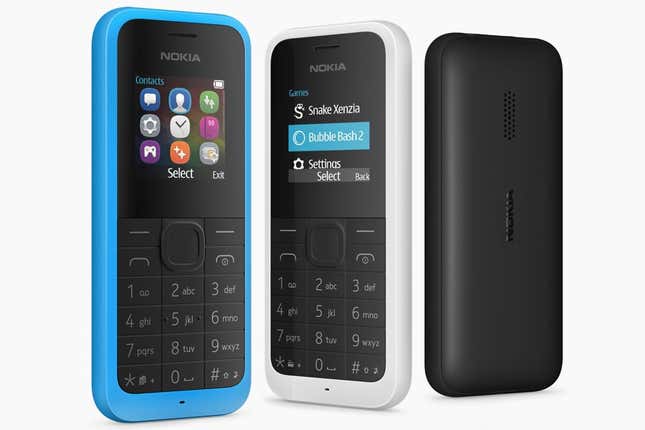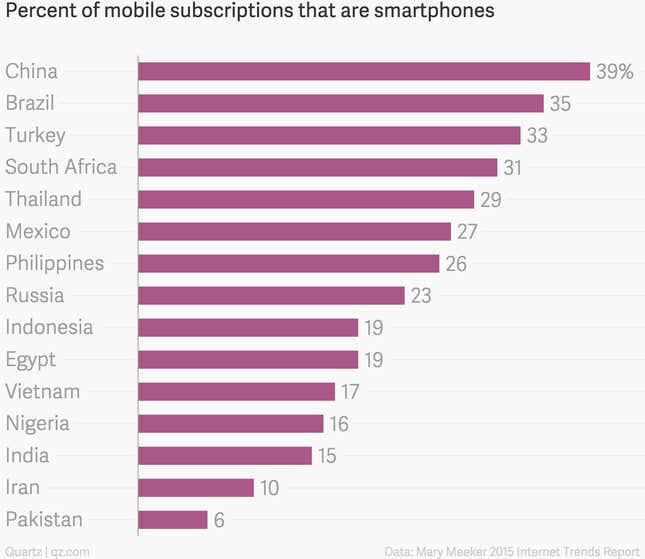Microsoft released a new phone under the Nokia brand this week. It has no 3G or LTE, no Wi-Fi, no touchscreen, no apps, no Facebook, and the only accessory listed on its product page is an extra battery. It costs $20 before tax and will, in all likelihood, be a massive success.
Who would want to buy a basic phone with no internet in 2015, a time when the every big tech company on the planet is talking up its efforts to bring the next billion online via mobile? Lots of people, it turns out. Some 590 million this year, to be precise.

These buyers of so-called “dumb phones” (which do little except make calls and text) and “feature phones” (which offer a few more, um, features, but don’t have touch screens, GPS, or the other accoutrements of smartphones) can be divided into three categories of buyers, argues Microsoft.
The first is the brand new mobile-phone buyer: These include children getting their first device in wealthier countries, as well as the roughly 300-million Sub-Saharan Africans expected to get their first cell phones over the next decade. And of course, Indians, Chinese, and Latin Americans.
The second category is made up of people who simply don’t want smartphones. Whether you call them luddites or grandparents, the fact is that there are plenty of people in the world who would rather not be tweeting and Facebooking and consuming content on their phones all day.

The third is people who need a second phone. These include those who travel a lot, or who want something with a decent battery to get them through a camping trip or a music festival. More than a quarter of Nokia’s feature phone buyers get one as a second phone; that’s why Europeans buy as many feature phones as Latin Americans, according to internal numbers in Microsoft’s research.
The numbers are substantial, even in the West. According to Gervais Pellissier, who runs the Europe business (except France) for Orange, one of the world’s largest mobile operators, some 20% of the network’s customers in Western Europe use feature phones, while some 40% in Eastern Europe do so.
This third category also includes some unlikely folks. Stephane Richard, the CEO of Orange, carries around an old Nokia in addition to his smartphone. So do the founders of WhatsApp (though theirs connect to the internet). I’m a technology reporter and although I own several smartphones, I keep a cheap Nokia for traveling. Some even use older phones as a status symbol (paywall).
Put these three categories together and you have a pretty substantial market. And indeed, the last version of Microsoft’s new phone—the Nokia 105—has sold 80 million units since its release in February 2013.
A feature, not a bug
Of course, there’s little doubt that dumb phones and feature phones are a shrinking market. Between the first quarter of 2013 and the first quarter of 2014, the market for non-smartphones shrunk by a 14%, according to CCS Insight (pdf), a research firm. This year, some 590 million non-smartphones will be sold. By 2019, that number will shrink to 350 million.
But 350 million phones in one calendar year is still a lot of phones. And it is, as Microsoft’s Pekka Haverinen of Microsoft’s feature phone division tells Quartz, a predictable market with high volumes and a high market share for Microsoft.
It’s not just device-makers who stand to profit from cheap, basic phones. Ericsson reckons (pdf) that by 2020, there will 9.2 billion mobile subscriptions, of which 1.4 billion will non-3G subscriptions. This huge market is hungry for services.
U2opia, a Singapore-based company, allows dumb phones to connect to services such as Facebook and Twitter without an internet connection; it has nearly 20 million users. And there are a host of financial services aimed purely at people with dumb phones. Even Facebook realizes that feature phones are sticking around. It has released a way for non-smartphones to use the social network and allows advertisers to target these users specifically.
“There are vibrant communities that aren’t catered to by the App Store or [Google] Play,” says Marco Veremis, CEO of Upstream, a mobile marketing and content company. Upstream sells apps for feature phones in emerging markets, most of which have smartphone penetration rates of just 35%. The company boasts an average revenue per user in Brazil of $6—about the same as mobile operators make from their customers.

In a market such as Nigeria, any talk about smartphones is “academic,” in Veremis’s words. Even if you have one, 3G coverage is not nationwide and power is in short supply. Most Nigerians need a phone that lasts a week, not half a day. As he puts it: ”Feature phones are going nowhere.”
Even in the midst of the smartphone revolution, the vast majority of the world still uses dumb phones. They should get more attention than they do.
